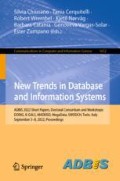Abstract
The goals of business process automation and improvement are to increase productivity, satisfy clients and workers, and reduce costs. In this paper, we improved and redesigned processes to use electronic documents, improve the velocity of activities, and enhance transparency of processes using the DMAIC method (Define, Measure, Analyze, Improve, and Control). First, we used Papyrus to represent the activity diagram for the insurance claim process. Then, using Acceleo, an algorithm was constructed using the retrieved XML to change the non-improved XML file into an improved one. Finally, using the updated XML, we produced the improved UML activity diagram.
Supported by Development and Innovation Fund of Hungary, financed under the Thematic Excellence Programme TKP2020-NKA-06, TKP2021-NVA-29, COST Action ‘CA19130.
Access this chapter
Tax calculation will be finalised at checkout
Purchases are for personal use only
References
Van der Aalst, W.M.: Business process management: a comprehensive survey. International Scholarly Research Notices 2013 (2013)
Beerepoot, I., van de Weerd, I., Reijers, H.A.: Business process improvement activities: differences in organizational size, culture, and resources. In: Hildebrandt, T., van Dongen, B.F., Röglinger, M., Mendling, J. (eds.) BPM 2019. LNCS, vol. 11675, pp. 402–418. Springer, Cham (2019). https://doi.org/10.1007/978-3-030-26619-6_26
Asowski, B.W.: Model-to-text transformations. Inf. Syst. 84, 62
Casebolt, J.M., Jbara, A., Dori, D.: Business process improvement using object-process methodology. Syst. Eng. 23(1), 36–48 (2020)
Damij, N., Damij, T.: Business process modelling and improvement using TAD methodology. In: van der Aalst, W.M.P., Benatallah, B., Casati, F., Curbera, F. (eds.) BPM 2005. LNCS, vol. 3649, pp. 380–385. Springer, Heidelberg (2005). https://doi.org/10.1007/11538394_27
Eshuis, R.: Symbolic model checking of UML activity diagrams. ACM Trans. Softw. Eng. Methodol. (TOSEM) 15(1), 1–38 (2006)
Frank, U.: Outline of a method for designing domain-specific modelling languages. Technical report, ICB-research report (2010)
Frank, U.: Domain-specific modeling languages: requirements analysis and design guidelines. In: Reinhartz-Berger, I., Sturm, A., Clark, T., Cohen, S., Bettin, J. (eds.) Domain Engineering, pp. 133–157. Springer, Cham (2013). https://doi.org/10.1007/978-3-642-36654-3_6
Gray, J., Neema, S., Tolvanen, J.P., Gokhale, A.S., Kelly, S., Sprinkle, J.: Domain-specific modeling. In: Handbook of Dynamic System Modeling, vol. 7, p. 7-1 (2007)
Harrington, H.J., et al.: Business process improvement. Association for Quality and Participation (1994)
Johannsen, F., Fill, H.-G.: Meta modeling for business process improvement. Bus. Inf. Syst. Eng. 59(4), 251–275 (2017). https://doi.org/10.1007/s12599-017-0477-1
Kashfi, H., Aliee, F.S.: Business process improvement challenges: a systematic literature review. In: 2020 11th International Conference on Information and Knowledge Technology (IKT), pp. 122–126. IEEE (2020)
Kherbouche, M., Mukashaty, A.A., Molnár, B.: An operationalized transformation for activity diagram into YAWL. In: Developments in Computer Science, pp. 17–19 (2021)
Kumarapeli, P., De Lusignan, S., Ellis, T., Jones, B.: Using unified modelling language (UML) as a process-modelling technique for clinical-research process improvement. Med. Inform. Internet Med. 32(1), 51–64 (2007)
Missaoui, N., Ayachi Ghannouchi, S.: Pattern-based approaches for business process improvement: a literature review. In: Park, J.H., Shen, H., Sung, Y., Tian, H. (eds.) PDCAT 2018. CCIS, vol. 931, pp. 390–400. Springer, Singapore (2019). https://doi.org/10.1007/978-981-13-5907-1_42
Rashid, O.A., Ahmad, M.N.: Business process improvement methodologies: an overview. J. Inf. Syst. Res. Innov. 5, 45–53 (2013)
Szelągowski, M.: Evolution of the BPM lifecycle. In: Federated Conference on Computer Science and Information Systems, pp. 205–211 (2018)
Tunney, P., Reeve, J.M.: The impact of continuous improvement on the design of activity based cost systems. J. Cost Manag., 43–50 (1992)
Vergidis, K., Tiwari, A., Majeed, B.: Business process improvement using multi-objective optimisation. BT Technol. J. 24(2), 229–235 (2006). https://doi.org/10.1007/s10550-006-0065-2
Acknowledgements
The project was supported by the “Application Domain-Specific Highly Reliable IT Solutions” project that has been implemented with the support provided by the National Research, Development and Innovation Fund of Hungary, financed under the Thematic Excellence Programme TKP2020-NKA-06, TKP2021-NVA-29 (National Challenges Subprogramme) funding scheme. Furthermore, this article is partly based upon work from COST Action ‘CA19130—Fintech and Artificial Intelligence in Finance—Towards a transparent financial industry’, supported by COST (European Cooperation in Science and Technology), https://www.cost.eu/actions/CA19130/, accessed on 2021-12-20.
Author information
Authors and Affiliations
Corresponding author
Editor information
Editors and Affiliations
Rights and permissions
Copyright information
© 2022 Springer Nature Switzerland AG
About this paper
Cite this paper
Kherbouche, M., Zghal, Y., Molnár, B., Benczúr, A. (2022). The Use of M2P in Business Process Improvement and Optimization. In: Chiusano, S., et al. New Trends in Database and Information Systems. ADBIS 2022. Communications in Computer and Information Science, vol 1652. Springer, Cham. https://doi.org/10.1007/978-3-031-15743-1_11
Download citation
DOI: https://doi.org/10.1007/978-3-031-15743-1_11
Published:
Publisher Name: Springer, Cham
Print ISBN: 978-3-031-15742-4
Online ISBN: 978-3-031-15743-1
eBook Packages: Computer ScienceComputer Science (R0)

